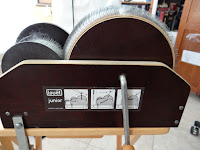
I ordered some fleece in a couple of different breeds and colors and made lots of overspun yarn. Then someone pointed me to learning videos, and I saw someone spin art yarn on a spinning wheel. She made it look so easy. Abby Fraquemont spins some of the most beautiful yarns I have ever seen; so does Natalie Redding. I began to wonder if I could spin on a wheel. So I signed up for a course at The Yarn Lady, our local yarn shop. Lady Marge brought her beloved Lendrum wheel and showed me briefly how to use it. Then I sat at the wheel and began over-spinning some more fleece. When I'd gotten the hang of the wheel, she gave me some soft, multi-colored fleece, and the result was wild. I asked about adding bits and pieces to it; so we did! I have worn my first wheel-spun yarn as a cowl, but the bits and pieces aren't staying put. But, I knew I could use a wheel.
In April 2015 at Stitches South in Nashville, I sat down at a Lendrum similar to Lady Marge's at Carolina Homespun and began spinning. My grin was so big my lips hurt. The wheel came home with me. It's a double treadle, Scotch tension with a bulky flyer.
The car was loaded with fleece and wheel.
Then I visited The Barn Yarn in Clermont, Florida, and spied some washed alpaca fleece - bought some. Online again, I watched Natalie do lock spinning, and I pulled out some of my washed alpaca to lock spin. The result was interesting, sturdy and became clouds in one of my wall hangings.
 I began spinning everything I had, ordered more, combined handspun and commercial yarns into wild looking pieces - none of which were longer than about 25 yards.
I began spinning everything I had, ordered more, combined handspun and commercial yarns into wild looking pieces - none of which were longer than about 25 yards.
While I was away at Stitches South, my honey went to the shearing at our favorite alpaca farm and brought me the fleece of Godiva, a chocolate yearling. It is wonderfully soft and makes a marvelous yarn.
Now, I was smitten with the bug of processing my own fleece. While living in North Carolina, I had visited a couple of farms and had some alpaca fleeces already, had bought some dog brushes to use as carders and some screens for washing raw fleece. So, I was ready. I had found some wool fleece that I washed and carded and used a blending board to make it into rolags (tubes of fleece for spinning).
One day, Jan said, I know someone who has a drum carder for sale. That's much faster and easier way to card fleece than dog brushes; so I bought it from Gerri, who used to raise Angora bunnies. She gave me all the fleece she had left. My living room floor was full of boxes of drum carder and fleece - angora, cashmere, wool/silk, and other stuff.
I've managed to get the carder set up on a wooden tv tray so that I can move it outside to work on the porch, and I've repacked the boxes of fleece into only four containers.
A couple of days ago, I pulled out some angora and sat down at the wheel. A few minutes later, I had some angora yarn - a worsted weight with some nice bumps and slubs that will make great sand for one of my Ocean Hours panels - expensive sand, but, hey, that's okay for right now.














